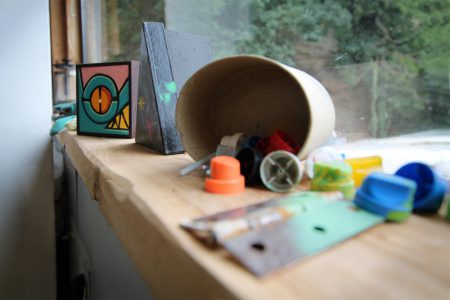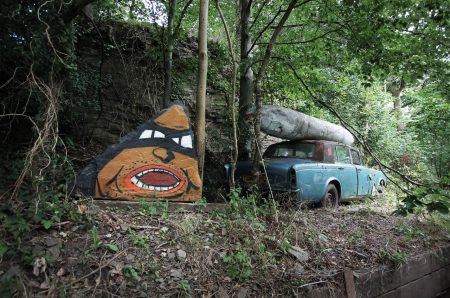Rowdy is perhaps best known for his crocodiles, which stalk the urban landscape with a quiet menace, and his cast of other characters which abound with abrasive energy. But the Bristol-based artist’s abstract landscapes, which can be read as both highly political but also deeply personal, represent a far more reflective and contemplative side to his work. An entire building is depicted by an individual mark such as the smudge of a fingerprint, the stroke of a paintbrush or the squirt from a spray-can and this reduces the city down to an abstracted, minimalist form with the different marks being used to bring out the essential characteristics of the individual buildings. This reductionist approach can be viewed as mirroring the city as shaped by those with financial and political power who have erected monolithic buildings that marginalize and diminish individuals in favor of institutions and corporations; a kind of manifestation of the historian R. H. Tawney’s proclamation that “Freedom for the pike is death for the minnow.” However, the paintings also suggest a tender and intimate relationship between the artist and the city, free from the audible and visual noise that distracts us from our immediate environment.
We recently had an opportunity to catch up with the artist in his studio just outside Bristol to discuss his roots as an artist, his current projects and the multi-faceted nature of his work.
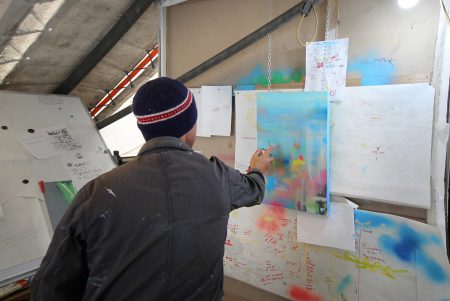
Feralthings (F): You’ve been painting continuously since 1986/87 and a lot of other writers have come and gone during that time, so what do you think it is that’s kept you creating?
Rowdy (R): I saw the graffiti scene for a couple of years and thought ‘I’ve got to do this!’ I felt a bit too young to be perhaps going out there doing it, but once I picked up some paint it was like after trying magic mushrooms for the first time; you think ‘life’s always going to be a bit different from now on’. I knew that, even at a young age, and I thought ‘what can be better than this’. As I got older, there were other things to get a high from like drugs or booze but I just knew that graffiti was right for me. I’ve barely ever stopped. It’s good to have a break just to refuel but there’s so many different routes to go down and to explore as an artist that there’s no real reason to stop and you can always re-explore old ideas. There’s always something to paint or something to paint on, so it’s just endless.
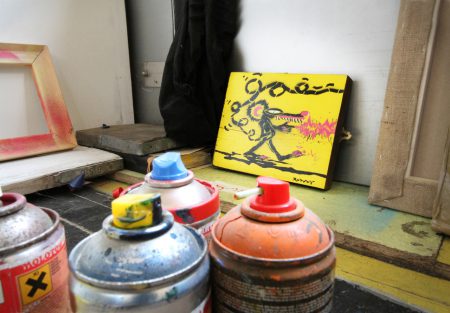
F: Has your path always been quite organic or have you made deliberate choices throughout your career?
R: I think it just depends on where you’re living, your circumstances and, to an extent, money; but I come from an era where you would just steal the paint. Many years later, we’ve moved into the emulsion-era and you can do lots of big paintings with emulsion which is very cost effective too. So even if I’m a bit destitute, I’ll always have plenty of paint and ideas to go forward with.

F: The most recognizable feature of your work is the crocodile; what does that mean to you personally?
R: Prior to the crocodiles I was just easing off on the letterforms and I was doing lots of Rowdy pieces up until that point. I just felt that the crocodile still encapsulated me being Rowdy, but it was in character form which could be recognized by more people because the graffiti pieces could only really be recognized by people in graffiti-circles. I’ve stuck with the crocodile character but I make sure that lots of my other characters and work gets recognized; I was hoping to do more stuff with Lilo Cat this year. But it’s definitely signatory to me and the sharp teeth have a good graffiti aesthetic; if you see them on the street I think you can tell that is someone from a graffiti background, as opposed to a more modern street artist. It still carries some of those elements and it just has a bit more energy, a bit more bite and bit more recognition to it.
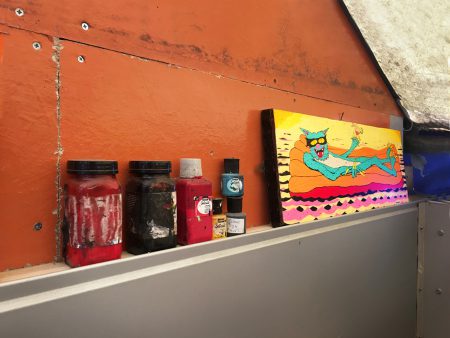
F: Your mentioned Lilo Cat and I guess one of the things which unifies all your characters is that they’re all outcasts and outsiders, so what is it that draws you to those characters?
R: When I’m developing characters I want something that’s a bit gnarly and scratchy. There’s only certain characters I’d work on – I wouldn’t do a giraffe as there’s nothing Rowdy about that to me – but I do pick on certain things. Whether they’ve got claws or bugged out eyes and how I can apply them to a context; they’re all considerations. So something like the cat is a bit more ‘holiday’; it’s a lot more of a relaxing character. The mouse, known as Pete Jaundice, is a lot more of a springing-about-town kind of character. I’m always looking at the space and thinking what is going to work in there and often the reason the croc gets done more is that I go for more unusual slithers and spaces that only a long panoramic piece will fit on. I like playing with the architecture of the city. I’m really into that physical, geographic nature of spaces. I find that interesting and I’m also interested in some of the spots that the graffiti guys get to and working out how you might apply paint to a certain surface.
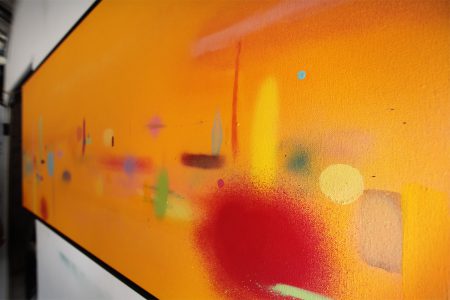
F: And then there’s the complete other side of your work – the abstract landscapes – do you approach that in quite a different way to your street work?
F: Well, it’s been said some of them are inspired by views from doing rooftop graffiti and that’s true to an extent. But now with the advent of drones we see a lot more high up photography; that has stopped me wanting to paint that kind of view looking down because drones have given us all that view of the city. Other work is much more on a horizontal level, as if I was on a boat. When I’m doing graffiti I’m looking up, but I like to hit things from all angles and sometimes even straight on with a slightly naive element.
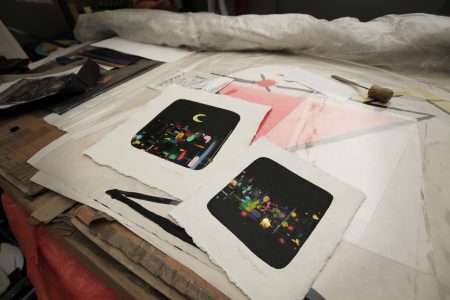
F: So with your landscapes, how much of it is a physical representation and how much is the vibe you get from the area you’re painting?
R: If I haven’t been somewhere visually interesting for a while I just have to make a landscape that I’m longing for. But there are instances where I’m looking for an interesting composition as part of a series where I am painting something closer to what I’m visually seeing. But I’m still exploring places that I’ve never been; this piece [below] has an element of New York and you could be looking at Manhattan from Greenpoint with the river cutting through it but it could also be the Thames estuary in London. I’m not interested in doing scenes of London and putting iconic buildings in my paintings but I think there are still ways of doing that quite cleverly or subtly. I did a large yellow canvas a while ago called ‘Calgary’ and it’s got its title on the back; but I’ve reworked about 80% of that painting so it’s something else now, so is it still Calgary? Like a chair that’s been reupholstered and had a leg replaced. I started some of these paintings five years ago and am I even that person anymore? I like the works that have a little bit of ambiguity about them.
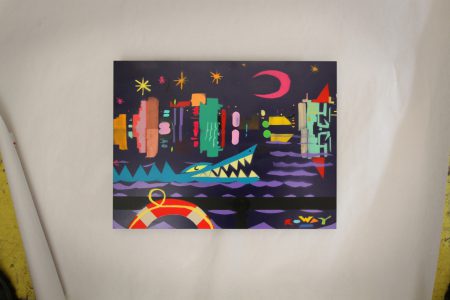
F: I guess it makes you think about how unique or homogenous our global cities are these days.
R: I think that’s what was refreshing about a recent trip I took to Paris; it’s trying hard to keep its identity. And that’s obviously one of the pitfalls of London; you’ll never get away from the Thames which is physically always going to be there. But the way a lot of the city is changing it’s just becoming a big Starbucks-y looking place on a street level in a lot of areas. I think it’s a bit sad; I mean, of course, there’s a lot of markets and individualism and that’s what I want to reflect with the different buildings and mark-making, working on a much more individual level. And I think that’s also what graffiti does; it acts as a counterweight to what the corporates are trying to do to our public space. The powers that be just want to take over when something begins to work in its own right as a community-led, slightly anarchic place which has a real cultural interest.

F: One of the things which seems to lie within all your work is a distinct political edge; is that a conscious decision?
R: I think that’s just who I am; I’m not trying to spell out that message. Years ago, I think I was a bit more. Now it’s subliminally in there and intertwined with all the work but it’s just what I do, so I don’t think about it all that much. But there is that thing of just trying to celebrate alternative culture and trying to keep those elements and ethics alive. Obviously, I need to sell work and all artists worry if they’re selling-out. That’s what really prompted me to do the abstract work which had no obvious form and it was a freer expression, like what I’d previously found in graffiti. Being an abstract artist in the UK is actually quite a tricky job because we don’t embrace abstraction in the same way they do in somewhere like the States. You do realize here that you’re living in quite a conservative country but you can play to that; I recently sold a piece to someone who works for The Daily Telegraph and I gave her a copy of my book. I thought it was interesting because then my work will be popping up at their offices on Buckingham Palace Road where I can’t get into that building. nd I think that’s an interesting thing as an artist; it’s a way of affecting people without ever having met them or them visiting a gallery with my work. It’s a way of subtly getting to people, or not so subtly; that was the great thing about Burning Candy [the crew which Rowdy was a member of alongside Sweet Toof, Lucas Price and others], we definitely weren’t subtle, but I’ve also needed a vehicle to be a little more subtle as well and bring out a much deeper and more drawn out process in the work.

F: And tell us a bit about your animations which brings an element of narrative into play.
R: I’m doing weird characters and abstract cityscapes but I always need more, whether it’s sculpture or animation, otherwise it becomes a bit restrictive. Taking streets scenes from Stokes Croft in Bristol or Roman Road in London, places that still have a bit of character and a bit of grit about them; I just wanted to explore visions and ideas a bit further. I had done a couple of short films but I suddenly found animation to be a really interesting way of working and some of your first memories as a child were of watching cartoons like Captain Caveman, which were pretty silly, and realizing how amazing they are. Burning Candy was pretty silly and I’ve always liked the humor in the work and I thought animation was perfect for that; The Treatment Worx really helped that process along. It suddenly meant I could say a lot more than I could in one single painting or street hit and helped me to gravitate towards a place like Polucalopolis, where the longest animation is set. We got Jules from the Zen Hussies to do a lot of the voiceovers and brought a voice to these characters. And we were using original music. These are nice things to be able to explore with fellow creatives.
F: You’ve always worked quite collaboratively with Souls On Fire and Burning Candy; is that something that you’re drawn to?
R: I think it’s really important to do that when the time suits because you spend so much time on your own as an artist; sometime I can be in the studio all day and not talk to anyone. So it is nice to collaborate because all artists are individual people that often don’t get the opportunity to talk amongst ourselves and discuss ideas. So when a collaborative process does come together, I think it’s really good when there’s an exchange of ideas and critique of the work. Also, there are some artists that I wouldn’t necessarily collaborate with because their work is too different to my own but it doesn’t mean we can’t be in quite a focused group show together. If you put your own shows together then you can set the agenda and I think that’s what we were doing as Burning Candy; we were just doing what we wanted to do. If I’m putting shows together and I want to just bring an element of something else together, then a gallery isn’t necessarily best placed to do that because they need to sell, but curating your own shows can be a cultural vehicle to express ideas other than just straightforward business.
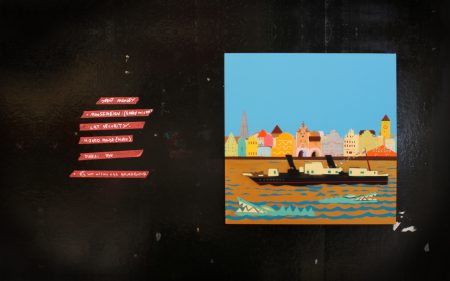
F: And what have you got coming up in the near future?
R: The Rawrulists show opened last weekend and I’ll be adding in a few pieces; that closes on 30th September. Then next weekend [15th and 16th September 2018] we’ve got something at Rockaway Park with live music and live painting; there’ll be lots of art on display and that’ll be an all-weekender. We did it for the first time last year and it went really well, so this will be the second foray into the world of putting on a big event out here. Filthy Luker will be putting some stuff in, there’ll be some of Joe Rush‘s sculptures, we’ve also got a new piece from Dan Rawlings and 3Dom and a few other artists will also be getting involved. The following Thursday [20th September] we’ve then got Art Show 2 opening in Totterdown with Paris, Jessie Woodward, Louise Kelly Phillips, Sue Gent and myself; that runs until 23rd September.
The Rawrulist exhibition is at The Farm, Hopetoun Rd, Bristol BS2 9YL until 30th September 2018. The Rockaway Weekender is on at Rockaway Park, Eastcourt Rd, Temple Cloud, Bristol BS39 5BU on 15th and 16th September 2018. Art Show 2 is on at The Totterdown Centre, 144 Wells Road, Bristol, BS4 2AG from 20th to 23rd September 2018.
Discuss Rowdy here.

